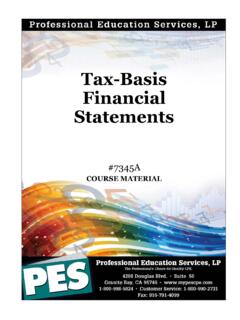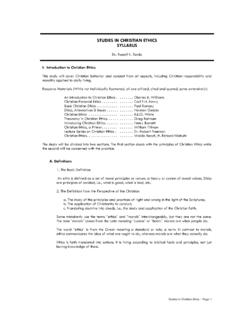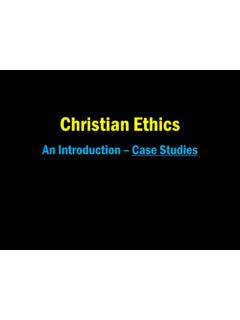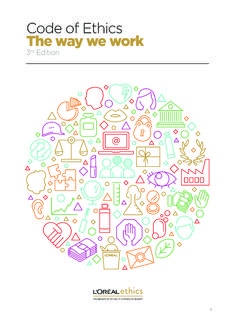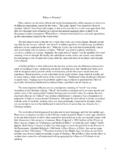Transcription of Ethics for Texas CPAs - Professional Education Services
1 Course #4005B Course Material Ethics for Texas CPAs Ethics FOR Texas Copyright 2007 by Dr. Jae Shim and Colleen Neuharth McClain, CPA. All rights reserved. No part of this course may be reproduced in any form or by any means, without permission in writing from the publishers. By Dr. Jae Shim and Colleen Neuharth McClain, CPA Table of Contents Table of Contents Page Chapter 1: Ethics and Ethical Reasoning 1-1 Review Questions & Solutions 1-11 Chapter 2: AICPA Ethics 2-1 Review Questions & Solutions 2-44 Chapter 3.
2 Standards of Ethical Conduct for Practitioners of Management Accounting and Financial Management for Certified Managerial Accountants (CMA) and the Certified In Financial Management (CFM) 3-1 Review Questions & Solutions 3-4 Chapter 4: Texas Ethics 4-1 Review Questions & Solutions 4-18 Glossary Index Chapter 1: Ethics and Ethical Reasoning 1-1 Chapter 1: Ethics and Ethical Reasoning LEARNING OBJECTIVES: After studying this chapter, you will be able to: 1.
3 Define Ethics . 2. Differentiate between amoral and ethical values. 3. List and characterize two systems of Ethics . 4. Differentiate between legal versus ethical codes. 5. Discuss the development of law and Ethics . 6. List examples of philosophers who contributed to the development of Ethics . Ethics is the science of morals. A moral is an accepted rule or standard of human behavior. The understanding of accepted is accepted by society, and accepted only in so far as the behavior in question being behavior that affects others in the society, even if only indirectly. The implication of this definition is therefore that private actions that have no impact on others are a matter for personal morality, which is not of business or organizational concern. However, the distinction between personal morality and business morality may not always be so clearly defined.
4 This is because individuals bring personal values to their jobs and to the real or perceived problems of moral choice that confront them at work. Moral choices sometimes must be made because of tensions within individuals, between individuals, or between individuals and what they believe to be the values that drive their organizations. Furthermore, business organizations do not operate in a social vacuum. Because of the ways business organizations can and do affect the lives and livelihoods of society at large, some would argue that business organizations are kind of moral agents in society. Therefore, managers and the general public alike often wrestle with defining exactly what constitutes the ethical way of doing business, and what constitutes proper constraints on individual self-interests, and by whom shall these constraints be imposed.
5 A further complexity results from the fact that businesses are increasingly becoming global in nature. Different countries have or seem to have vastly different customs and values. Understanding and assessing whether and how these different cultural and ethical conflicts should be taken into account is often most difficult. Chapter 1: Ethics and Ethical Reasoning 1-2 ATTITUDES TOWARD Ethics AMORAL: Condone any actions that contribute to the corporate aim. Getting away with it is the key. No set of values other than greed. LEGALISTIC: Obey the letter of the law but not the spirit of it, especially if it conflicts with profits. Ethics ignored until it becomes a problem. RESPONSIVE: Take the view that there is something to gain from ethical behavior, Using Ethics as a tool to attain corporate aim.
6 EMERGING: Ethical values becoming part of the culture. Codes of Ethics being action documents, and likely to contain statements reflecting core values. ETHICAL: Total ethical profile. Everything done is ethical, and the right thing is always done by everyone. The ideal. In general, a key focus of Ethics is the concept of integrity (or honesty). Integrity in broad terms will imply that no business-persons in the course of their business functions should be party to the falsification of any facts or information or make any statement which knowingly is misleading, false or deceptive. Another major focus of Ethics is Professional competence and due care, which implies that business professionals should always perform their functions in accordance with the law and regulations.
7 In other words, business transactions and Professional functions should not be undertaken unless one possesses the required competence and technical skills. A more controversial focus is the area of freedom from conflicts of interests. The preferred position of many is that one should always avoid concurrent involvement in any business, occupation or activity, which might result in the compromising of integrity, objectivity and independence of decision making. ETHICAL SYSTEMS Utilitarianism (teleological Ethics ) The promotion that the best long-term interest of everyone concerned should be the moral standard: one should take those actions that lead to the greatest balance of good versus bad consequences. Deontology (Kantian Ethics ) It deals with the concept of duty and the rightness of acts.
8 It emphasizes maxims, duties, rules, and principles that are so important that they should be followed whatever the consequences. Chapter 1: Ethics and Ethical Reasoning 1-3 In defining law and Ethics and their relationship to each other it is necessary to distinguish between moral and legal rights and duties. Morally, a person's rights consist of claims that he can justly make to the conditions of well-being; his duties consist of what he can justly contribute to well being. Legal rights and duties that is, claims and obligations enforceable at law - may or may not be fully in harmony with prevalent moral opinion systems in which law and Ethics and religion are closely interwoven. The impact of moral opinion on law varies with the type of political structure and influence of public opinion.
9 In free societies, the ultimate justification of law is that it serves moral ends. But the dependence of law on moral principles must not be taken to imply that there is a set of moral principles which can be lain down for guidance. However, most free societies are coming to be more or less consistent in principles that draw the line between law and morals. The task of Ethics becomes two-fold: to bring out what is involved in the notion of a principle or norm of action and to recognize the ideals that serve as agencies of guidance and control. A number of consistent principles recognized in modern society are the individual responsibility and equity. The end of law is to secure the greatest possible general individual self-assertion. In the Judeo-Christian ethic, responsibility is a given: the best ordering of human society in which the individual may come to full manhood and satisfying existence.
10 On the basis of equitable doctrine we can say confidently that morality is inseparable from the legal order; that right and wrong is part of the legal order. HISTORICAL FOUNDATIONS OF LAW AND Ethics The great religions of the world gave birth to several concepts that evolved into structural precepts for society. A commonality of precepts evolved with the passing of tribal customs and tribal belief systems and the rise of the great religions of the world. "The monotheistic idea of God unifies and coordinates the spiritual goods of the race. The unity of GOD involves the unity of all classes of men. This is a long step toward equality. The sense of sin became part and parcel of the common consciousness. It is a leveler and equalizer," for the good of the tribal society now becomes for the good of the individual. It must come to pass that a given society, if it is to retain the right to exist, must be continually extending the experience of its best things to men who were at one time outside, the pale of the best.






